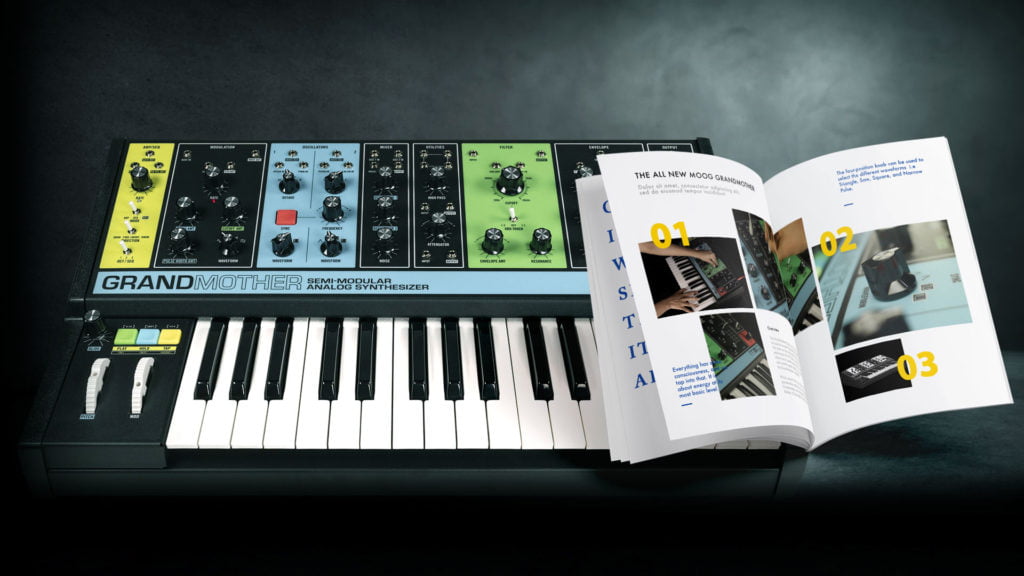In this Article.
- Overview
- Oscillator Section
- 2.1 Waveform Knob
- 2.2 Octave Knob
- 2.3 Frequency Knob
- 2.4 Sync Knob
- 2.5 Wave Out Knob
- Mixer Section
- 3.1 Oscillator Knob
- 3.2 Noise Knob
- Filter Section
- 4.1 Cutoff Knob
- 4.2 Envelop Amount Knob
- 4.3 Resonance Knob
- 4.4 KBD track Switch
- Modulation Section
- 5.1 Rate Knob
- 5.2 Waveform Knob
- 5.3 Pitch AMT Knob
- 5.4 Cutoff Knob
- 5.5 Pulse Width Knob
- Utilities
- Envelope Section
- ARP/SEQ Section
- Output
- Conclusion
Inspired by the classic Moog Modular Synthesizers.
The Moog Grandmother is a new road for Moog Music Inc. The Moog Grandmothers circuits are based upon pre-existing Moog technologies, that dates back to the classics from 1960s and 1970s to the more recent ones.
1. MOOG GRANDMOTHER OVERVIEW
The Moog Grandmother gives us a broad array of musical sounds, like blips & blops to FM, that can be achieved without any patching at all. However, patching allows us to create new kinds of audio and control signal paths, that maximises the Moog Grandmother’s abilities. What’s more? The rear panel of the grandmother allows us to expand our Grandmother to EuroRacks, DFAM or a Mother 32 through a EuroRack Out port.
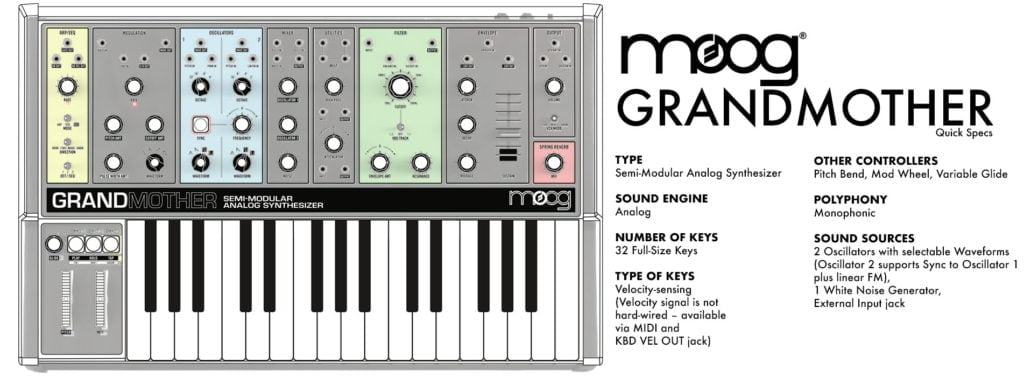

Everything has some consciousness, and we tap into that. It is about energy at its most basic level.
Dr. Robert Moog.
2. OSCILLATORS SECTION
The Moog Grandmother has two oscillators which are almost of the same identical design. Each oscillator has its own Octave and Waveform settings. Oscillator 2 is equipped with a Frequency knob to detune it from Oscillator 1. Every waveform has its own harmonic content which is based on the strength of overtones that it contains. These overtones impart a particular timbre, or character, to the sound of an Oscillator.

— 2.1 ) WAVEFORM KNOB
The four-position knob can be used to select the different waveforms i.e Triangle, Saw, Square, and Narrow Pulse.
— 2.2) OCTAVE KNOB
This four-position switch is used to select the fundamental octave setting for oscillators.
NOTE: Oscillator 1 Octave setting have octave choices of 32’, 16’, 8’, and 4’, while for Oscillator 2 are 16’, 8’, 4’, and 2’.
— 2.3 ) FREQUENCY KNOB
The Frequency knob detunes oscillator 1 over a range of +/-7 Semitones. As we bring the knob towards the center position (12 O’clock), it puts Oscillator 2 in unison with Oscillator 1.
— 2.4 Sync Button
The SYNC button locks the pitch of Oscillator 2 to Oscillator 1. This forced synchronisation causes the waveform of Oscillator 2 to take on a more complex wave shape, as it works to stay aligned with Oscillator 1. Sync is useful for creating sharp, metallic, and flange-like sounds, which also ensures that the pitch of Oscillator 2 stays locked to Oscillator 1.
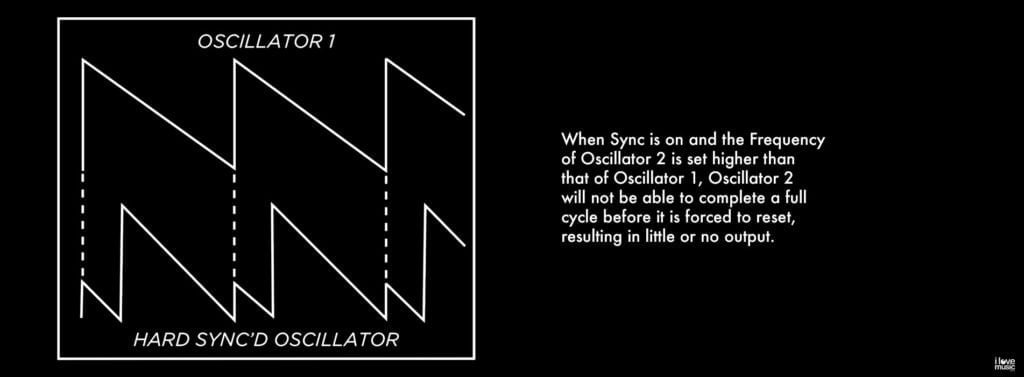
TIP: Applying modulation to the Frequency of Oscillator 2 is a great way to enhance the Sync effect.
— 2.5) WAVE OUT
Keeping in mind the semi-modular nature of the Moog Grandmother, patching audio signals can bring about a whole new experience of creating sound. For example, an audio signal coming from the Wave Out output can further be routed into the Pitch In of Osc 2, which would modulate the pitch(frequency) of Oscillator 2.
The Wave Out signal is determined by the settings of OCTAVE and the WAVEFORM knobs of the Oscillator 1.
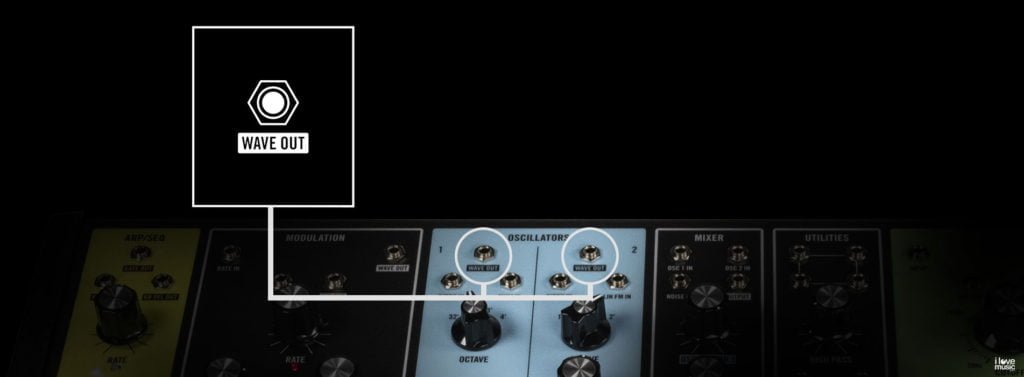
NOTE: There is a FINE TUNE knob located on the rear panel for adjusting the overall tuning of the instrument.
3. Mixer Section
The Mixer is where all of the sounds within the Moog Grandmother are blended together before it reaches the filter. We have individual control over two oscillators & a noise generator.
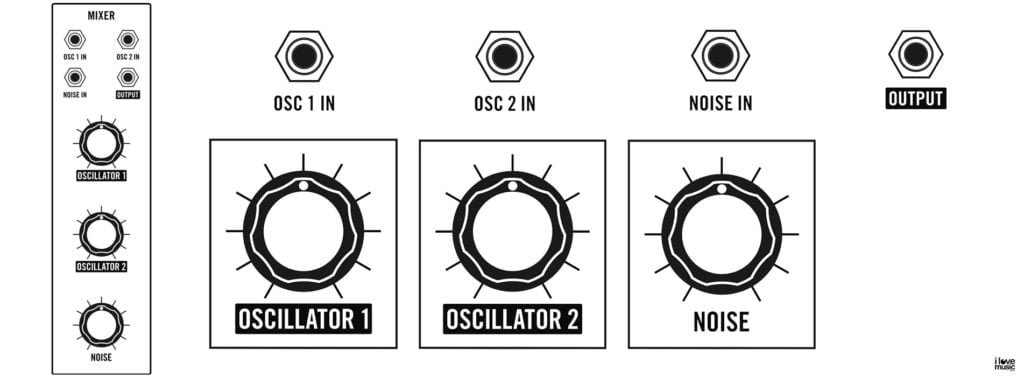
— 3.1 Oscillator Knobs 1 & 2
These knobs set the level of Oscillator 1 & Oscillator 2 respectively, as it enters the mixer. Turning the OSC knobs at 1 O’clock will impart gentle distortion while cranking it to higher settings will start giving more overdriven tones.
— 3.2 Noise Knob
The NOISE knob sets the level of Moog Grandmother’s white noise generator as it enters the mixer. Settings above 1 O’clock will begin to impart similar characteristics as discussed above for both the oscillators.
NOTE: The Mixer section also has patch points that allow us to route each hardwired source (Oscillator 1, Oscillator 2, Noise) to be replaced with an external audio signal.
4. Filter Section
Moog Grandmother has the classic 24dB/octave Moog Low Pass Ladder Filter which has been the primary essence of the “Moog sound”. The Low Pass Filter primarily removes the harmonic information of the upper part of the audio spectrum and allows the lower frequencies to pass unaffected. This is also the foundation of subtractive synthesis. You could also crank the resonance to hear sparkly harmonics, without losing much of the low end.
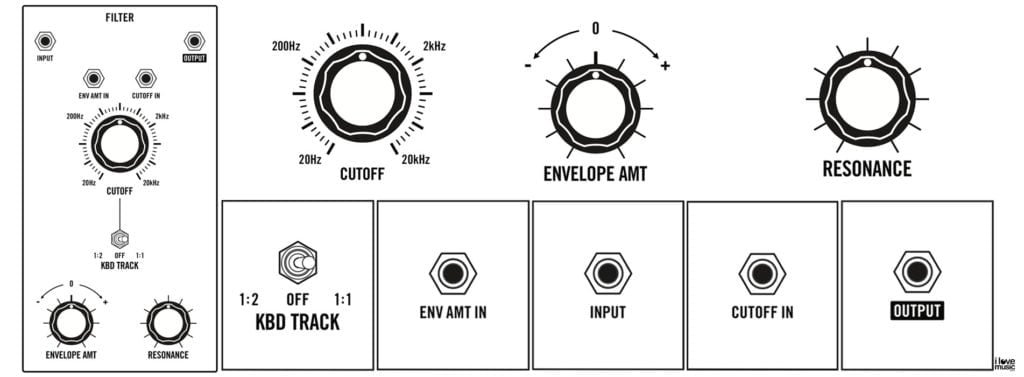
— 4.1 Cutoff Knob
This knob specifies the frequency at which the Filter starts reducing harmonic content. In simple words, anything above the Cutoff frequency is reduced while the sounds below the Cutoff frequency will pass unchanged. It is one of the most effective ways to apply modulation to the sound, hence getting motion & character.
— 4.2 ENVELOPE AMT KNOB
The ENVELOPE AMT knob decides the amount of control signal created by the Envelope. This envelope can then be applied to the Filter’s Cutoff over a period of time. It is a bipolar knob, so turning the ENVELOPE AMT knob anti-clockwise will simply flip the shape of EG(Envelope Generator) i.e instead of the envelope’s attack raising the cutoff frequency, it would now instead lower the cutoff frequency.
— 4.3 Resonance Knob
A small boost at the edge of cut off frequency is called Resonance. That is, the resonance knob decides the amount of amplification near the cutoff frequency.
— 4.4 KBD Track Switch
Keyboard Tracking or KBD Track decides the amount of filter cutoff applied depending on the octave of the note pressed. This means that higher notes on the keyboard will now produce brighter sounds than those notes played at a lower octave. The KBD Track switch has three positions to select KBD tracking. (1: 2, OFF & 1:1)
At the off position notes played will have no effect on the cutoff frequency while at 1:1 position, the note played will have a complete (1:1) effect over Cutoff frequency. At 1:2 the note being played on the keyboard will affect the Cutoff frequency at the half of its value.
5. Modulation Section
Modulation can be applied to several destinations at once via the Modulation section. The Modulation section is based around an analogue oscillator operating in the low-frequency range, commonly known as an LFO (Low-Frequency Oscillator).
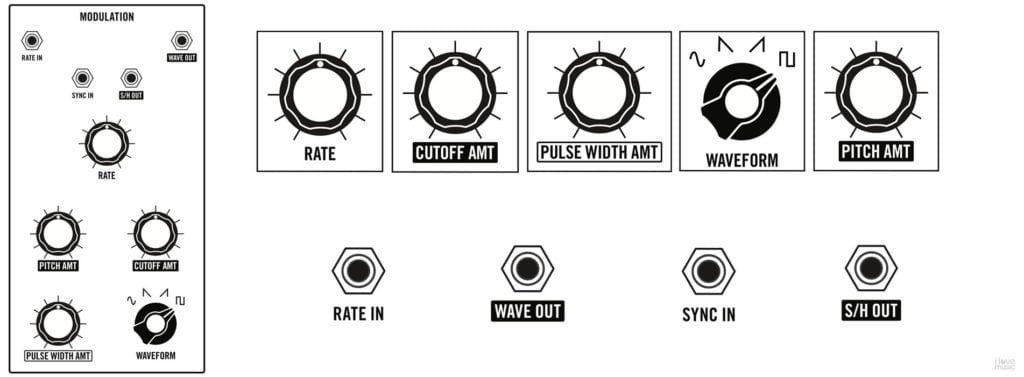
NOTE: The PITCH AMT, CUTOFF AMT, and PULSE WIDTH AMT knobs are used to specify the amount of modulation to be applied to these parameters.
— 5.1 Rate Knob
The RATE knob sets the frequency of the LFO from .07 Hz to 1.3 kHz. The LED will flash more frequently based on the Rate set.
— 5.2 Waveform Knob
We have a four-position knob which is used to select the Waveform for the Modulation. The waveforms are Sine, Sawtooth, Ramp, and Square.
— 5.3 PITCH AMT KNOB
The knob decides the depth of modulation applied to the Pitch of Oscillators 1 and 2.
— 5.4 CUTOFF AMT (AMOUNT)
The knob decides the depth of modulation applied to the Cutoff frequency of the Low Pass Filter.
— 5.5 PULSE WIDTH AMT
The knob decides the depth of modulation that is applied to the Pulse Width of the Square and Narrow Pulse waves of Oscillators 1 and 2.
NOTE: For the depth of modulation to be applied & heard, the MOD wheel needs be at greater than the minimum position.
6. Utilities
The tools given in Utilities such as a four-point Mult, high pass filter, and bipolar attenuator puts you into the doorway of modular analogue synthesis. This section has parts that are not patched internally.
NOTE: A four-point Mult helps you to merge four signals. A bipolar attenuator has a single Input and Output which helps you to reduce the strength of the control signal routed to it. The high pass filter with 1 input* & 1 output** needs to be patched to include it in the signal path.
*An audio signal connected to the input will be processed by the High Pass Filter
**A signal available here is the output of the High Pass Filter
7. Envelope Section
Moog Grandmother Envelope generator has four main stages ATTACK time, DECAY time, SUSTAIN level and RELEASE time.
— The ATTACK knob determines the amount of time required for a signal to rise from zero to its maximum level after a key is pressed.
— The DECAY knob determines the amount of time required for the signal to fall from the maximum level when a key is held.
— The SUSTAIN controls the level post the Attack and Decay. The signal will remain at the level set by the SUSTAIN slider for as long as the key is held.
— The RELEASE knob controls the amount of time required for a signal to fall from its Sustain level to zero after the key is released.
8. ARP/SEQ Section
This section contains two very important features: the Arpeggiator and the Sequencer.
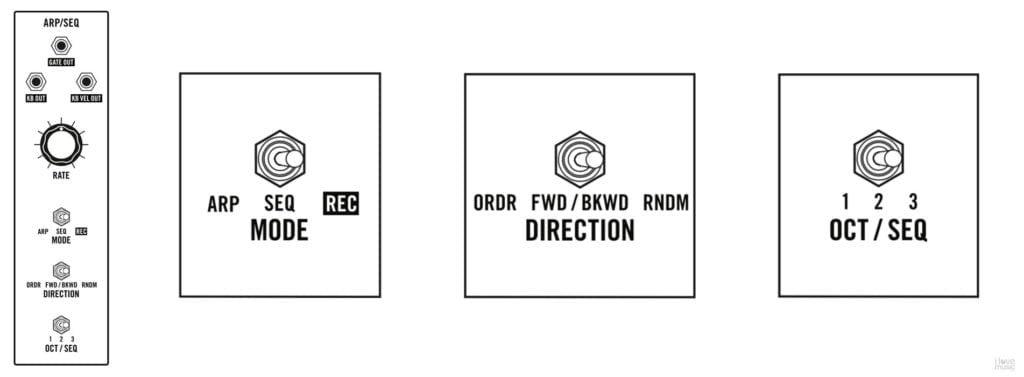
ARPEGGIATOR
The Arpeggiator takes the notes that are being played on the keyboard and plays them in a pattern. We can select the notes and also provides the option of repeating the pattern in different octaves.
SEQUENCER
The is a step sequencer that can store 256 steps per sequence. Each step can be entered as a Note or a Rest. Individual steps can also be entered with a Tie or an Accent. We can make three separate sequences which can be stored & called upon when needed (eg.for a performance). Sequence memory is retained even with the power off.
9. Output Section
Output section decides how the final sound is being heard. The output section contains a VOLUME knob, MODE switch, and a SPRING REVERB MIX knob.
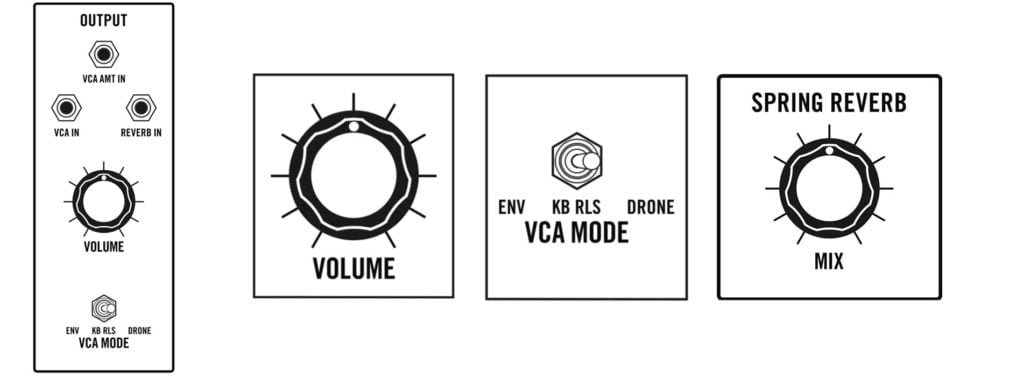
The VOLUME knob decides levels for the main out. It is placed after the SPRING REVERB MIX knob in the signal path. Also, the level of the EURORACK output at the rear panel is unaffected by the VOLUME knob settings.
The mode switch has three modes
— VCA MODE.
The Voltage Controlled Amplifier, or VCA, is an amplifier that can be modulated from different sources to control the Moog Grandmother’s output level.
— ENV MODE (Envelope)
In this mode, the final Volume is controlled by the Envelop Generator.
— KB RLS MODE (Keyboard Release)
In the KB RLS mode, the sustain level is on for as long as a note is pressed. Released the not the VCA will follow the Envelope Release to decide how long it takes for the sound to fade.
— DRONE MODE
In this mode, there is no effect of the envelope generator on the sound. The Moog Grandmother outputs level will remain the same once a key is engaged, irrespective of it being held. Used to make textured sounds and ambient drone sounds.
10. Conclusion
The capabilities within the Moog Grandmother are immense, especially when you start taking advantage of its patching. Whether you are new to the domain of synthesis or an experienced hand, the Moog Grandmother possesses a vast and dynamic range of sounds for every individual. Whether you are into experimental music or want to shred or if your interest lies in exploring the ambient side, you will love spending time with the Moog grandmother.
What’s worth mentioning is the rear panel through which the Moog Grandmother can be further infused into a modular or semi-modular setup i.e a DFAM, Mother 32 or to your EuroRack modular system. 
Besides the Fine Tune knob, we have an audio section, an arp/sequence CV section and a midi section.
The Instrument IN allows you to route any external instrument (like a guitar) into the Moog Grandmother. You can also directly route your other Modular systems like the EuroRack, into the Mixer In, to give you even more oscillators for soundscaping.
For more details on the Moog Grandmother, please refer to the manual.
Explore more synths with us:
- Moog:
- Moog Grandmother
- Moog LittlePhatty
- Arturia
- Korg
- Waldorf

